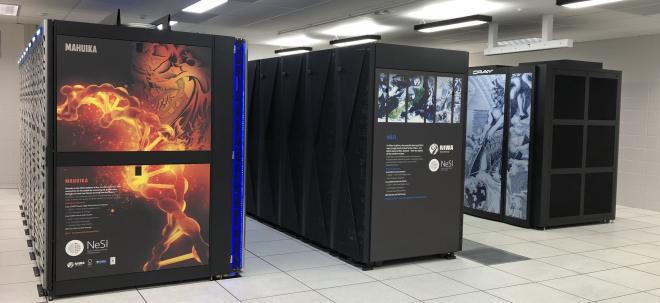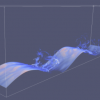Empowering students through HPC skills
The challenge:
The next generation of scientists entering research fields need to understand how to use supercomputing tools to aid their research and augment traditional experimentation.The solution:
Providing graduate students with a hands-on introduction to high performance computing early in their research career.The outcome:
With NeSI support, a student was able to simulate the molecular dynamics of phenylalanine in a wild-type enzyme after the 12-week paper, with no previous scientific computing experience.
Last year, the University of Waikato and NeSI collaborated on a masters paper to provide a practical hands-on introduction to using national-scale research facility such as NeSI. Cristal Bader, an honours student studying enzyme kinetics and using molecular dynamics at University of Waikato, was one of the first participants in that pilot paper. Building on the knowledge and skills she gained in the paper, Cristal was able to use NeSI’s Mahuika supercomputer to computationally model the enzyme she was studying.
Participating in the paper enabled Cristal to use her computational research as part of her honours thesis, and has also equipped her with valuable skills to take forward into her research career. We asked Cristal to share some of the highlights of her experience taking the paper and accessing NeSI as a first-time user.
* * * * * * * * * *
“The University of Waikato ran a supercomputing paper for the first time this year, so I took it as part of my honours degree. The course took 12 weeks to complete,” Cristal said. “The first six weeks was learning how to use NeSI and the second six weeks was applying the skills you have learnt to your own project. As part of the course I wrote a report on the findings that attempted to replicate the molecular dynamics of the wild-type enzyme that was central to my honours project.”
Cristal had already carried out experimental investigations with the MaIL wild-type enzyme to understand how the movement of phenylalanine amino acids within the enzyme would change its heat capacity. With her experimental results in hand, Cristal wanted to see if she could recreate them using a computer model, to see how the phenylalanine molecules were behaving during each step of the experiment.
“In my simulation, I could follow through every step – from heating, to equilibration and its final form – and show that it was the same protein. I liked that you could show something experimentally and then support it theoretically using computational tools, or vice-versa. If you can show something both theoretically and experimentally, you’re in a pretty good position with your research,” Cristal said.
Cristal – like many of the other students enrolled in the Scientific Supercomputing paper – had no prior scientific computing experience. Cristal was using the Assisted Model Building with Energy Refinement (AMBER) program to simulate the molecular dynamics of phenylalanine. Once she began writing her simulation, she relied on support from NeSI support specialist, Ben Roberts, who installed AMBER onto the Mahuika supercomputer and provided troubleshooting to Cristal during the final stages of the project.
“I don’t think I would have been able to finish this simulation to such a high level without Ben’s help. Ben had previously done two years of AMBER development in the US, so he was able to explain all the intricate things I would never have found in a manual. It made it so much easier to have someone who not only knew the answers but was concerned with giving me an adequate understanding of what was happening so that I could learn,” Cristal said.
Cristal said part of her reason for taking the paper as part of her honours degree was because she felt that knowledge in High Performance Computing (HPC) would be an important part of her skillset for future research opportunities and employers.
“In ten years’ time there will be a screening process for this sort of thing – in the same way the ability to do polymerase chain reaction (PCR) would have been in the past. Initial studies in the field of enzyme kinetics, would have used random mutagenesis and then PCR to amplify the mutated gene to determine the outcome. With HPC and molecular dynamics software, it’s a lot faster and more user-friendly, both factors that will continue to be more valuable to labs in the future,” Cristal said.
While this part of Cristal’s honours degree is now finished, she will continue to study the molecular dynamics of enzymes. Cristal said she can see herself returning to use NeSI resources for her research in the future and that it will be an extremely valuable skill to have. The partnership between University of Waikato and NeSI is giving New Zealand early career researchers the relevant skills to be competitive within the international stage.
Do you have an example of how NeSI support or platforms have supported your work? We’re always looking for projects to feature as a case study. Get in touch by emailing support@nesi.org.nz.







